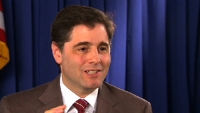Chairman Genachowski to make FCC a 21st century agency

Speaking last week at a Tech Policy Summit at CES in Las Vegas, FCC chairman Julius Genachowski outlined three ways the FCC will approach spectrum challenges in the coming years.
The first will be to find more spectrum, which he called a limited resource. The second is that spectrum will be used in a more efficient manner. He highlighted alternatives that would make its use more efficient, such as secondary licensing and more flexibility with licensing rules generally. Incentives for the private sector to use spectrum in an efficient manner were also mentioned. And the third, he said, is to promote innovative technologies.
“Some people assume that all broadband is wired, but it’s also wireless,” the FCC chairman said. “Our data shows there is a looming crisis. We may not run out of spectrum tomorrow or next month, but it’s coming and we need to do something now.”
Genachowski said the commission also plans to look into increasing spectrum flexibility and opening secondary markets for licensed spectrum use. He said the FCC will perhaps allow more use of unlicensed spectrum, such as the white space spectrum that sits between broadcast channels.
A controversial proposal on the table involves taking away spectrum from current spectrum license holders, such as TV broadcasters and government agencies, and reallocating those licenses to broadband wireless providers. The chairman said the need for more spectrum for wireless broadband services is so great that some spectrum will have to be freed up both from broadcasters and from government agencies.
“Based on the amount of spectrum that will be needed to meet the demands of the country, we will have to find spectrum from government and commercial uses,” he said. “It’s too early to say where a reasonable place is to get that spectrum. But it’s hard to see a path where we don’t have to reclaim some spectrum.”
Genachowski also encouraged more competition in the TV set-top box market and connected TV markets. He said the statute that was put in place to encourage competition in this market and the previous efforts to get CableCard technology into the market to make consumer set-top boxes available had failed.
The professional video industry's #1 source for news, trends and product and tech information. Sign up below.
And as a result, innovation has lagged in this area. “We look at this and say that maybe TV can be a part of the broadband solution,” he said.
Genachowski also said throughout the past year, increasing pressure has been placed on government entities to embrace policies and practices that are more “government 2.0.” By this, he means using technology to create a feedback loop between citizens and the FCC.
Recognizing difficulties in both communicating what impact the decisions of the FCC have and getting information in the hands of citizens in an easily digestible format, Genachowski highlighted ways the agency would make a transition to a “21st century agency.”
Recently, he noted, the FCC launched a new platform that allows citizens to tell the FCC how it can better do its job and communicate with the public. The chairman also pledged to make the FCC more responsive.
